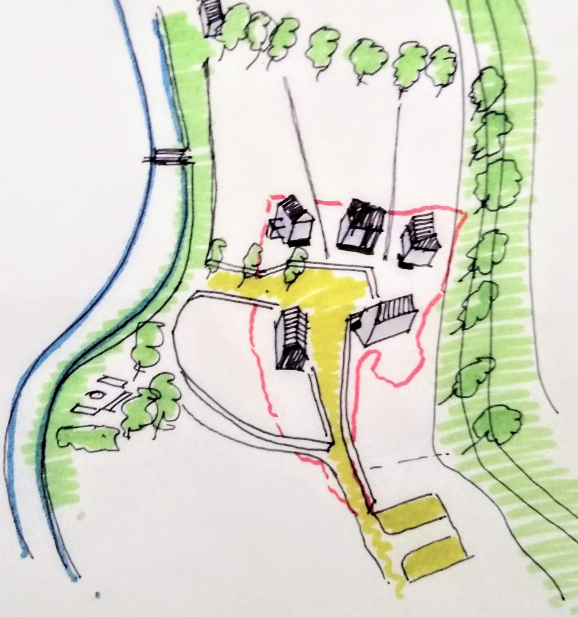Case Study: Living in an eco-community
Kate Rawles is a writer and environmentalist who is part of an environmentally conscious co-housing community in the South Lakes. The plan in the small community is for each family to build their own house and, as a group, protect and enhance the biodiversity of the land. We spoke to Kate shared about plans for the site and working together to improve the environment.

Q: Could you explain briefly how where you’re living differs from a conventional UK living situation, i.e. one family living as a single unit?
A: There will be five families – of different sizes and ages – living in the same location. We all have (or will have, when they are built!) our own houses and gardens, similar to many conventional UK living situations. But we will also have a community building where we’ll meet regularly, and we have shared projects, such as maintaining the site and managing the land for wildlife, which we all contribute to.
The houses will be freehold and owned by individual families, but they are situated on land owned and managed by the company we’ve formed to do this. Anyone who joins would have to be willing to sign up to the principles of the company, as well as its vision and values statement – which includes our commitment to consensus decision-making as well as our ecologically-focused values – and to commit a minimum amount of time per month to community tasks. (It’s a pretty small amount and most of us end up doing a lot more, but because we want to.)
Q: What inspired you to want to live in a co-housing setting?
A: I’ve wanted to do this for about a decade now. I really value working with others as part of a project with shared values. We are all quite different but we all have a commitment to living more sustainably, and we all bring different perspectives on what this means and how to achieve it. This can be challenging, of course, but almost always in a good way!
I also really appreciate regular chats and interactions, even if brief, with people who I’ve chosen to live with, and that happens organically on-site without having to make a date to meet them as so many social interactions involve. I think it’s really healthy to depend less on partners/others in the household for these kinds of everyday interactions and chat, too.
Having said all that, I also very much value my privacy – the model of co-housing we’re developing definitely respects this for everyone. I think it’s the best of all worlds in this sense.
Q: How do you think this way of living contributes to a more ‘sustainable’ way of life?
A: Most obviously in our case we’re committed to building low-impact eco-houses, using as much locally sourced material as possible (e.g. one of our team has been collecting storm-felled wood to build their house with, and for others to use too; another bought the felling rights to trees very close by that had to be felled anyway).
We have about 12 acres of land which is managed in various ways for environmental sustainability; for nature as well as people. We have already enhanced the diversity of the existing wildflower meadow and planted many hundreds of trees to strengthen the wildlife corridor along the River Sprint. We’re creating hedges instead of putting up fences along our boundaries.
In addition, we have a vision and values statement that includes strong commitments to co-existing with local wildlife and ecosystems, as well as ensuring any domestic animals including hens etc. have high-quality lives (animal welfare is an aspect of sustainability that is often overlooked.)
Many of us ride bikes – for transport as well as for fun, and we hope to have a shared electric vehicle at some point. We can reduce our need to buy things and contribute to over-consumption by sharing tools etc. and we hope to grow a significant proportion of our own food. Perhaps most importantly, we have an ongoing commitment to figuring out how best to support each other in reducing our negative environmental impacts, and increasing our positive ones – in relation to all aspect of sustainability, not just climate change – while leading high quality lives ourselves (albeit in a different way from the high-consumption, high-impact model of ‘high quality life’ that we’re often sold).
Q: How do you think the site will enable a way of living that can more easily co-exist with wildlife?
A: The site is organised – loosely – using an approach borrowed from permaculture. The area where the houses will be built is the area most focused on human needs, though there will also be organically managed gardens there.
Fanning out away from the houses, there will be allotments (again managed organically i.e. no artificial fertilisers or herbicides or pesticides) and an orchard, a sort of middle ground. Then there is the wildflower meadow, tree corridor and river bank where the needs of wildlife take priority. We plan to create a wildlife/swimming pond, we’ve put up bird boxes, including for owls, as well as bat boxes across the site, with more going up soon. The hedge will provide great extra habitat and cover for numerous species, as will the trees as they grow. So it’s a mixture of drastically reducing activities that cause harm to wildlife, such as using chemical pesticides, and consciously working to improve or introduce habitats where a diverse range of wildlife can live and flourish.
Q: Are there any principles of a co-housing site that could be replicated in a typical family home?
A: Any home interacts with the environment in all sorts of ways:
– how it is heated
– how people travel to and from it
– where the contents of the house come from
– how many of them there are
– how much waste it creates
– how much water it uses
– what sort of garden it has, if it has one
– etc etc.
There are constant opportunities to think about reducing negative environmental impacts, local and global, and increasing positive ones. Most homes have neighbours and one of the most important things any of us can do is talk with each other about how important these issues are, and how best to act in order to live more sustainably. So there’s definitely a sense in which the principles of co-housing can be enacted on a street, or with your neighbours if you’re in a more rural location.
